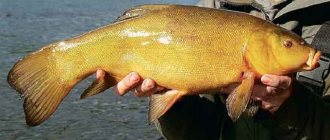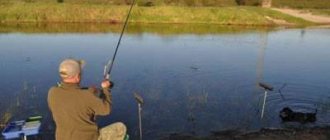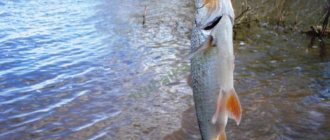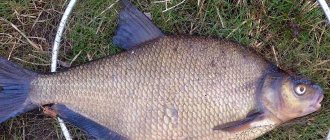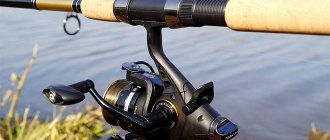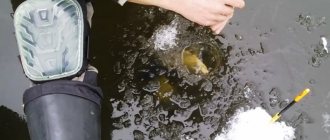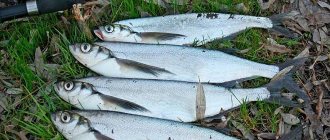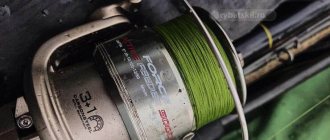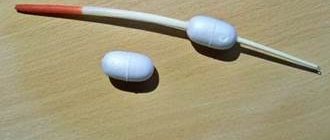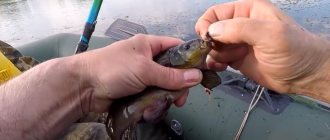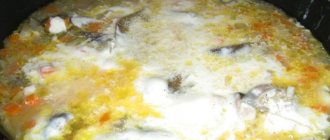Tackle
Tench is mainly caught in reservoirs with stagnant water, so rods up to 3.5 m long with a test weight of up to 40 g are sufficient. A spinning reel can have a size of 3000 to accommodate no more than 100 m of fishing line with a diameter of 0.25-0.28 mm. A fishing line with a diameter of 0.2-0.22 mm is used as a leash. If fishing is carried out in clean areas, but overgrown with aquatic vegetation, then thinner fishing lines can be used. The clutch is adjusted to the strength of the leash.
The hook is selected depending on the baits and attachments used: for worms you should choose hooks with a long shank; for baits of plant origin, hooks with a short shank are suitable.
Equipment
For bottom fishing, a good option would be a Gardner paternoster or a symmetrical loop. The feeder is attached using a swivel and clasp. Usually, feeders with wings that immediately rise from the bottom have proven themselves when fishing in such conditions, making various hooks impossible.
When going fishing for tench, you should stock up not only on feeders of various sizes, but also on sinkers with a wire eyelet, weighing from 5 to 20 grams. They are used after pre-feeding the fish. These sinkers do not cause much noise when falling into the water, and when pulling out the gear, they cling less to underwater obstacles.
Tench bite
A number of factors influence the bite. For example, if the water temperature drops, the tench often stops feeding completely, which is why there will be no bite. The best time for fishing is considered to be three hours after sunrise and several hours before sunset.
In warm but rainy weather, the bite is often observed throughout the day. Night fishing is effective in the summer season. The same can be said about fishing from a boat, in which the fisherman must be extremely careful so as not to scare away the potential catch.
Baits and baits
Tench, like many other species of fish, can feed on both animal and plant food. Here everything depends on the living conditions of the fish, weather conditions, as well as the main food. Which is thrown into the pond by fishermen. In some reservoirs it may prefer pearl barley, and in others it may prefer peas. And yet, his favorite bait is a dung worm, which he almost never refuses.
At the same time, tench can peck at:
- Bloodworm;
- Corn;
- Maggot;
- Bread.
Habitats
Tench is a heat-loving bottom fish, so you need to look for it in those parts of the river where there is no strong current and significant depth. This could be an oxbow with a large amount of horsetail, reeds and reeds - plants that occupy not the least place in its diet. On the lake these are quiet, calm areas, densely overgrown with vegetation.
There must be a thick layer of silt at the bottom, in which the red-eyed beauty scurries around for hours in search of animal food (larvae, worms, crustaceans and others). At night, it can rise to the surface to collect insects that have fallen on the water. In general, you need to catch it in quiet, well-warmed places with a muddy bottom and abundant vegetation.
Someone will ask, how do you throw feeder equipment into the grass? It is not necessary at all. The feeder and bait can be thrown under reed walls or through suitable windows. How to achieve big catches?
Over many years of practice in catching various types of fish, the most effective methods have been found:
[custom_ads_shortcode1]
Lure
To catch tench with a feeder, you can use any bait that has small fractions and is also flavored with line flavors. After preparing the main mixture, important ingredients should be added to its composition, such as:
- Bloodworm;
- Chopped worm;
- Steamed grains of various plants.
The bait is thrown before fishing, after which the feeder is replaced with a regular sinker. During fishing, bait should be added using a slingshot or by hand, if distance allows.
Choosing a place to catch tench in the fall
On an unfamiliar body of water, the choice of place for catching tench is carried out according to external signs. Then reconnaissance of the relief and bottom conditions is carried out. If favorable conditions for tench habitat coincide, you can start fishing. Signs of a promising place:
- Abundant coastal vegetation;
- Presence of emergent plants;
- Lush algae;
- Slow flow or no flow. On rivers there are low-flow bays, creeks and channel bends;
- Bottom turbidity rising to the surface along with air bubbles;
- Islands of reeds or other vegetation;
- Silted bottom;
- Depth changes;
- Bottom depressions (pits) in the coastal zone and near islands of vegetation sticking out on the surface of the water. Tench enter such places in late autumn.
Tench is not found in areas with a hard, silt-free bottom. Avoids fast channel currents and rapids.
Dependence of the bite on the season
Tench is a fairly heat-loving fish, and they begin to catch it with the arrival of real spring warmth.
In winter, tench are in a state of suspended animation and therefore do not feed.
As spawning approaches, tench begins to be actively caught, but the most favorable period is the post-spawning period, when the tench begins to really eat. Large specimens of this fish are more often found after sunset.
Spring fishing
As soon as the water in the reservoir warms up and green grass appears on the banks of the reservoir, the tench wakes up from hibernation and begins to actively feed. During this period, he gives more preference to bait of animal origin, such as a worm or bloodworm. When the gardens fade, the tench begins its spawning period and during this period the biting practically stops.
Summer fishing
When it’s hot outside, tench can be caught either early in the morning or late in the evening. It is at night that you can catch a large representative of this family. In summer, any bait and attachments can be used. Summer is considered the best period for tench fishing.
Autumn fishing
This fish can be caught until the massive leaves fall from the trees. The bite can be very active in cloudy, rainy but warm weather. During prolonged bad weather, the fish refuses to feed. In the autumn, when the fish begins to fatten, the best baits will be a worm, maggot, and bloodworm.
How to catch tench. We study the habits of fish.
Tench fish.
The first active bite begins with the appearance of young grass in the fields and greenery on the branches. As a rule, tench do not favor strong currents, and only take the fisherman’s “treats” well in the spring. Do not forget also that catching tench on a feeder will be successful if the water is at least 15 degrees.
It spawns in shallow water, in grassy areas with warm water (about 20 degrees). At the same time, it is voracious and takes bait well. Since June, the best time for biting is three hours after sunrise and the same amount of time before sunset.
After spawning, she leaves shallow water, returns to her usual habitats and begins to be careful when choosing food. However, when spawning has just ended, active feeding begins, which does not last long. It usually occurs at the very beginning of summer.
In warm and rainy weather you can fish for decent specimens all day long. Also in summer the fish bite well at night. You can even fish from a boat if you are careful and quiet. Choosing bait for tench.
Without the right bait/groundbait, it is impossible to catch a large enough fish. It is believed that when catching tench on a feeder, you can use any “treat” because it eats everything. However, in practice, he prefers all kinds of bugs and worms rather than corn or pea mixtures.
In the southern regions, the use of plant attachments is allowed in the summer. In reservoirs in the middle zone, it is better to feed with worms, bloodworms, dragonfly larvae and other living creatures. You can use cottage cheese or porridge as a filler. They will complement chopped insects, maggots and larvae.
Do you use ready-made feeder mixtures to catch tench? Then avoid strong-smelling, sweet or spicy options. In hot weather, you can add mayfly to the bait so that it floats near the surface and attracts hungry fish. Also, such a treat will come in handy on a warm night.
[custom_ads_shortcode3]
What you need for successful fishing
The successful outcome of catching tench on a feeder depends on many factors:
- choosing the right location;
- the presence of a large number of baits;
- pre-feeding of fish;
- correct fishing tactics.
If all these conditions are met, then you can count on some result. It should be said right away that these conditions can apply to catching any fish, since without a serious approach and preparation, you can hardly count on a good result.
Feeder fishing or bottom fishing is a very interesting form of recreation. This is dynamic fishing, as you constantly have to check the feeder for food. This is very important if fishing is carried out on the current. The consistency of the feeder should be such that it is washed out of the feeder within 5 minutes. Then the bite will be maintained at the proper level, and the fish will not leave the feeding area throughout the entire fishing period, which in turn will ensure the effectiveness of the entire fishing trip.
Line feeder tactics
When fishing near the shore, we use a light picker - with such a feeder it is easier to throw equipment into windows or onto the border of vegetation. It is advisable to start feeding two points - the second one a little further, on the first edge. If the reservoir is large, mostly shallow and covered in grass, we fish with at least one tackle in search mode, without food, systematically checking various points.
Tench is a cautious fish; the general rule for fishing with a feeder is less noise and delicate equipment. At the same time, you need reliable tackle. Tench is a strong fish, and weighing a kilo or more will give the angler a hard time in the process of fishing. If there is an abundance of aquatic vegetation, we use thicker leads – up to 0.2 mm, transparent or green-brown. In clear water we use thinner feeder leads - 0.14, 0.16 mm.
We feed the point right away, so as not to frighten the fish later with loud splashes when recasting. We throw 5-20 feeders to the point. In spring and autumn - finely divided food with a minimum of large particles, in summer - with porridge, chopped worms, corn, depending on what bites. In cold water it is important not to overfeed the fish, but in summer it’s the other way around – we deliver up to 50% of the total volume of bait from large, tasty feed fractions to the point.
After feeding, we change the feeder feeder to the smallest one or even put a sinker of 5-20 grams - to minimize noise. We equip the bait and throw the feeder to the point. There is no tempo fishing. At least 10-15 minutes should pass between feeder casts, and up to half an hour for large fish. The tench approaches slowly, without haste, and spends a long time trying the bait.
The quivertype of the feeder trembles slightly at the same time. Only when there is a clear pull should you hook – this can happen 10 minutes after the start of the bite. Sometimes the tench simply exhausts the soul with its long bites. However, sometimes it bites like an ordinary crucian carp - a couple of jerks and a stretch.
For especially cautious fish in shallow water, the tactic of recasting further from the point and tightening the equipment to the stern spot will help. To do this, we unclip the feeder, release 3-5 meters of fishing line, and clip it again. When casting the feeder, the equipment will now fly these 3-5 meters further.
After casting, carefully tighten the feeder rig onto the stern spot. This is necessary so as not to splash the line with casts directly over the head of the tench - if frightened, it may not return to the point. Between casts we experiment with baits and dips (garlic or some sweet aromas).
- Tench on a feeder in summer is best caught early in the morning or in the evening before sunset, and in some places at night. In spring and autumn, on fine, quiet days, the bite with varying intensity usually lasts all day.
- At long distances we use standard feeder tactics for feeding a point. However, we remember that you don’t need to re-cast the line often. We use feeders with minimal feed capacity, even the smallest sports thimbles. The lack of current allows this to be done.
- In search mode, we try to catch tench and flat using the method. Flat can also be thrown onto a fed window. It is important to choose bait here. Tench reacts more often to the worm, but on the pay sites it willingly takes pellets and boilies, which are common in such reservoirs.
Lure
The approach to bait for feeder fishing for tench is similar to catching spring crucian carp - it is advisable not to add any unnatural smells and a lot of large fraction, maximum - a handful of porridge and a few chopped worms for the rest of the base. It is better to start fishing with natural aromatics. The bait you need is heavy, inert, as for all bottom fish. A cloud of turbidity is more likely to attract small roach or bleak, rather than tench, and feed bloodworms - ruff or perch. It is advisable to darken the bait for tench with soil from the shore or immediately use dark mixtures.
Catching tench on a feeder in summer, in warm water, requires a larger amount of feed fraction in the mixture. We add to the food what the tench likes in that particular body of water. On the hook we fish with the same bait, larger and more noticeable. That is, if there is a bunch of dung beetle on the hook, there are chopped worms in the bait. If the corn contains maggots, add crushed grains and chopped maggots into the mixture. Fish in the summer need to be put on point. It is necessary for her to find food and start eating, rummaging in the grass and mud.
In different bodies of water, tench may react to some special additives:
- Boiled potatoes;
- Honey;
- Cottage cheese;
- Steamed grains - wheat, rolled oats (oats), pearl barley, millet.
Among the flavoring agents, we are experimenting with scents:
- Chocolate;
- Coriander;
- Caraway;
- Dill;
- Cinnamon;
- Vanilla;
- Garlic;
- Vegetable oils – sunflower, hemp, corn, flaxseed.
Baits and baits
More often, tench are caught on a feeder using a worm - a dung worm, a rain worm, or a crawling worm. However, you need to try maggots and bloodworms, and in the summer - plant baits and their sandwiches with worms, maggots or bloodworms. The bait for tench can be dipped, vegetable baits can be sweetened with honey or sugar. In summer, tench love sweet smells and tastes. In addition to animal feeder baits, in the summer we check:
- Steamed peas.
- Canned corn.
- Pearl barley or wheat.
- Crayfish meat or shrimp
- Mastyrki made with semolina or flour with the addition of peas, mashed potatoes, and cottage cheese.
Nozzle No. 1 is a worm in a bunch, so we try it first. Nozzle No. 2 - a sandwich of maggots and corn, smeared with honey (or dipped in this smell and sweetness). Then we check the other options. Read more about attachments for tench fishing.
